Introduction to Polynomial Functions
In the following problems, determine whether each expression is a polynomial. Select True if it is, select False if it is not.
Hint: In a polynomial, there cannot be any variable exponents or any variables in the denominator of a term.
|
|
|
| |
| 1) Polynomial?
|
 |
|
|
| |
|
| 2) Polynomial?
|
 |
|
|
| |
|
| 3) Polynomial?
|
 |
|
|
| |
|
In the following problems, determine the degree of the given polynomial.
Hint: The degree of a polynomial is the largest monomial degree of the polynomial.
|
|
|
| |
| 4) What is the degree of the polynomial?
|
 |
|
|
| |
|
| 5) What is the degree of the given polynomial? Explain how to determine the answer.
(Hint: Simplify) |
 |
20000 character(s) left
Your answer is too long. |
|
|
Attachments |
|
In the following problems, evaluate each polynomial expression for the indicated value of x.
Hint: Substitute the value for x into the expression and simplify.
|
|
|
| |
| |
|
| |
|
Adding or Subtracting Polynomials
In the following problems, express the sum or difference as a polynomial in standard form.
|
|
|
| |
| 8) What is the sum?
|
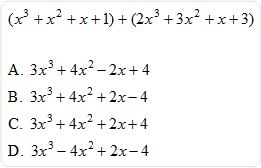 |
|
|
| |
|
| 9) What is the difference?
|
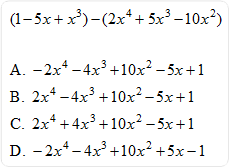 |
|
|
| |
|
| 10) Find the sum.
|
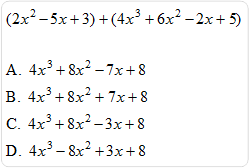 |
|
|
| |
|
In the following problems, find the perimeter of each geometric shape. Rewrite each measurement in standard form. (Figures are not drawn to scale.)
Hint: Find the perimeter by adding together the lengths of all the sides of the geometric shape.
Note: Assume sides that look equal in length, are equal in length.
To enter answers with powers, use a carat (shift + 6 on the keyboard) to represent the power as is shown in the example below.
|
 |
|
| |
| 11) Find the perimeter of the rectangle. Express the answer in standard form where the terms are in descending order by the exponents of the variables.
|
 |
4000 character(s) left
Your answer is too long. |
|
| |
|
| 12) Find the perimeter of the trapezoid. Express the answer in standard form where the terms are in descending order by the exponents of the variables.
|
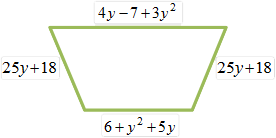 |
4000 character(s) left
Your answer is too long. |
|
| |
|
| 13) Find the perimeter of the regular pentagon. Express the answer in standard form where the terms are in descending order by the exponents of the variables.
|
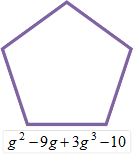 |
4000 character(s) left
Your answer is too long. |
|
| |
|
Products of Polynomials
For the next four problems, write the product as a polynomial in standard form.
|
|
|
| |
| 14) Find the product.
|
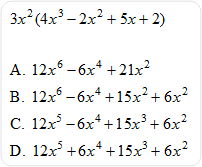 |
|
|
| |
|
| 15) Find the product.
Hint: Multiply the first two terms by using the FOIL method and then multiply the product by the third term.
|
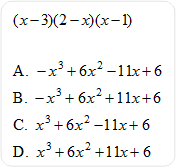 |
|
|
| |
|
16) Find the product.
Hint: Use the distributive property. |
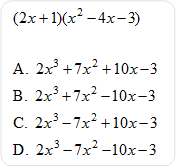 |
|
|
| |
|
Factoring Polynomials
For the next five problems, factor each polynomial by writing the polynomial as a product of more than two factors. State the answer or the letter of the correct answer, whichever is appropriate.
|
|
|
| |
| 17) Factor the polynomial completely.
Hint: Factor out the GCF first.
|
 |
4000 character(s) left
Your answer is too long. |
|
| |
|
| 18) Factor the polynomial completely.
Hint: Factor out the GCF first.
|
 |
4000 character(s) left
Your answer is too long. |
|
| |
|
| 19) Factor the polynomial completely.
Hint: Factor by grouping.
|
 |
4000 character(s) left
Your answer is too long. |
|
| |
|
| 20) Factor the polynomial.
Hint: Follow the pattern for a difference of cubes.
|
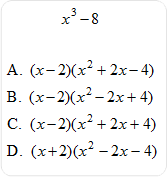 |
|
|
| |
|
The Factor Theorem
In the following problems, use substitution to determine whether the given linear expression is a factor of the polynomial.
|
|
|
| |
| 21) True or False? The linear expression, x – 1, is a factor of the given polynomial.
|
 |
|
|
| |
|
| 22) True or False? The linear expression, x + 6, is a factor of the given polynomial.
|
 |
|
|
| |
|
| 23) True or False? The linear expression, x – 3, is a factor of the given polynomial.
|
 |
|
|
| |
|
Long Division of Polynomials
In the following problems, divide by using long division. Recall that the term "quotient" is given to the result of a division problem.
|
|
|
| |
| 24) What is the quotient?
|
 |
4000 character(s) left
Your answer is too long. |
|
| |
|
| 25) What is the quotient?
|
 |
4000 character(s) left
Your answer is too long. |
|
| |
|
Synthetic Division
In the following problems, divide by using synthetic division.
|
|
|
| |
| 26) What is the quotient?
|
 |
4000 character(s) left
Your answer is too long. |
|
| |
|
| 27) What is the quotient?
|
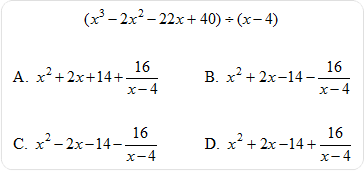 |
|
|
| |
|
| 28) What is the quotient?
Hint: Remember to add 0x as a placeholder.
|
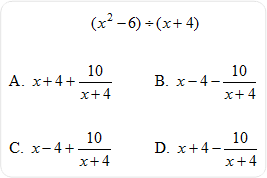 |
|
|
| |
|
| |
| 29) Solve for x.
Click here to review the content explanation for Logarithmic Functions.
|
 |
|
|
| |
|
| 30) How does the graph's appearance of log5(x – 4) compare to the graph of the parent function log5 x?
Click here to review the content explanation for Logarithmic Functions.
|
|
|
|
| |
|
| 31) Solve 3x = 62. Express the answer rounded to the nearest hundredth.
Click here to review the content explanation for Logarithmic Functions.
|
|
|
|
| |
|
| 32) State the expression as a single logarithm. Simplify, if possible.
Click here to review the unit content explanation for Natural Logarithms.
|
 |
|
|
| |
|
| 33) Gretchen invests $6000 at an annual rate of 5.4%. How much is the investment worth after 9 years if the interest is compounded continuously?
Click here to review the unit content explanation for Natural Logarithms.
|
|
|
|
| |
|
| 34) Extended Learning
Watch the following video, then write a five-sentence paragraph summarizing the video.
|
|
20000 character(s) left
Your answer is too long. |
|
|
Attachments |
|
| 35) If you were directed by your school to complete Offline Activities for this course, please enter the information on the Log Entry form. |
|
| No offline activities found |
0 Hour(s) & 0 Minute(s)
|
|
|
Attachments |
|